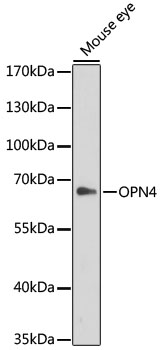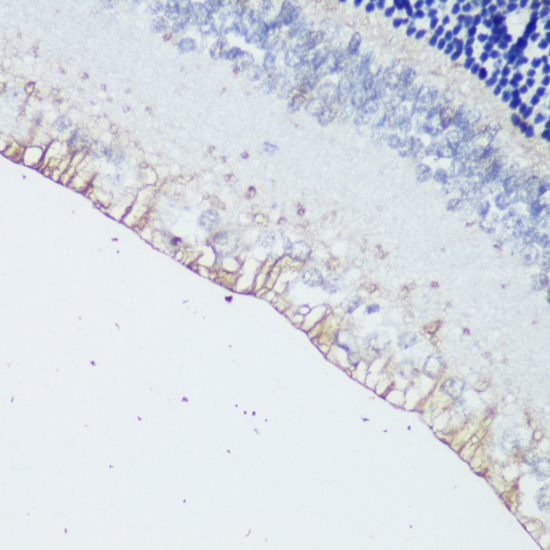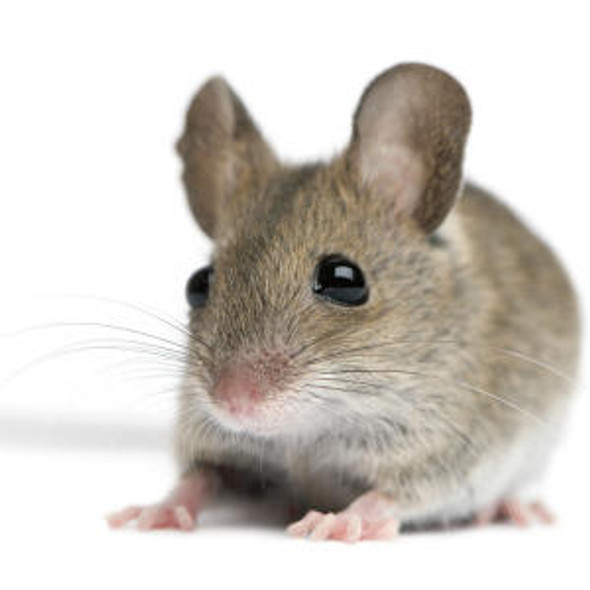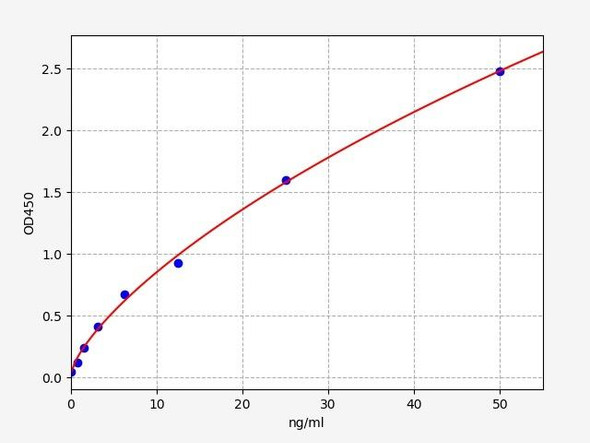Cell Biology Antibodies 6
Anti-OPN4 Antibody (CAB16289)
- SKU:
- CAB16289
- Product Type:
- Antibody
- Reactivity:
- Human
- Reactivity:
- Mouse
- Reactivity:
- Rat
- Host Species:
- Rabbit
- Isotype:
- IgG
- Antibody Type:
- Polyclonal Antibody
- Research Area:
- Cell Biology
Description
| Antibody Name: | Anti-OPN4 Antibody |
| Antibody SKU: | CAB16289 |
| Antibody Size: | 20uL, 50uL, 100uL |
| Application: | WB IHC |
| Reactivity: | Human, Mouse, Rat |
| Host Species: | Rabbit |
| Immunogen: | Recombinant fusion protein containing a sequence corresponding to amino acids 365-489 of human OPN4 (NP_001025186.1). |
| Application: | WB IHC |
| Recommended Dilution: | WB 1:500 - 1:2000 IHC 1:50 - 1:200 |
| Reactivity: | Human, Mouse, Rat |
| Positive Samples: | mouse eye |
| Immunogen: | Recombinant fusion protein containing a sequence corresponding to amino acids 365-489 of human OPN4 (NP_001025186.1). |
| Purification Method: | Affinity purification |
| Storage Buffer: | Store at -20'C. Avoid freeze / thaw cycles. Buffer: PBS with 0.02% sodium azide, 50% glycerol, pH7.3. |
| Isotype: | IgG |
| Sequence: | HPKY RVAI AQHL PCLG VLLG VSRR HSRP YPSY RSTH RSTL TSHT SNLS WISI RRRQ ESLG SESE VGWT HMEA AAVW GAAQ QANG RSLY GQGL EDLE AKAP PRPQ GHEA ETPG KTKG LIPS QDPR M |
| Gene ID: | 94233 |
| Uniprot: | Q9UHM6 |
| Cellular Location: | |
| Calculated MW: | 52kDa/53kDa |
| Observed MW: |
| Synonyms: | OPN4, MOP, opsin 4 |
| Background: | Opsins are members of the guanine nucleotide-binding protein (G protein)-coupled receptor superfamily. This gene encodes a photoreceptive opsin protein that is expressed within the ganglion and amacrine cell layers of the retina. In mouse, retinal ganglion cell axons expressing this gene projected to the suprachiasmatic nucleus and other brain nuclei involved in circadian photoentrainment. In mouse, this protein is coupled to a transient receptor potential (TRP) ion channel through a G protein signaling pathway and produces a physiologic light response via membrane depolarization and increased intracellular calcium. The protein functions as a sensory photopigment and may also have photoisomerase activity. Experiments with knockout mice indicate that this gene attenuates, but does not abolish, photoentrainment. Alternative splicing results in multiple transcript variants encoding different isoforms. |
| UniProt Protein Function: | Photoreceptor required for regulation of circadian rhythm. Contributes to pupillar reflex and other non-image forming responses to light. May be able to isomerize covalently bound all-trans retinal back to 11-cis retinal. |
| NCBI Summary: | Opsins are members of the guanine nucleotide-binding protein (G protein)-coupled receptor superfamily. This gene encodes a photoreceptive opsin protein that is expressed within the ganglion and amacrine cell layers of the retina. In mouse, retinal ganglion cell axons expressing this gene projected to the suprachiasmatic nucleus and other brain nuclei involved in circadian photoentrainment. In mouse, this protein is coupled to a transient receptor potential (TRP) ion channel through a G protein signaling pathway and produces a physiologic light response via membrane depolarization and increased intracellular calcium. The protein functions as a sensory photopigment and may also have photoisomerase activity. Experiments with knockout mice indicate that this gene attenuates, but does not abolish, photoentrainment. Alternative splicing results in multiple transcript variants encoding different isoforms. [provided by RefSeq, Jul 2008] |
| UniProt Code: | Q9UHM6 |
| NCBI GenInfo Identifier: | 71999143 |
| NCBI Gene ID: | 94233 |
| NCBI Accession: | NP_001025186.1 |
| UniProt Secondary Accession: | Q9UHM6,Q14D01, Q2PP22, Q8NGQ9, B7ZLB3, |
| UniProt Related Accession: | Q9UHM6 |
| Molecular Weight: | 55 kDa |
| NCBI Full Name: | melanopsin isoform 2 |
| NCBI Synonym Full Names: | opsin 4 |
| NCBI Official Symbol: | OPN4 |
| NCBI Official Synonym Symbols: | MOP |
| NCBI Protein Information: | melanopsin |
| UniProt Protein Name: | Melanopsin |
| UniProt Synonym Protein Names: | Opsin-4 |
| Protein Family: | Melanopsin |
| UniProt Gene Name: | OPN4 |
View AllClose








